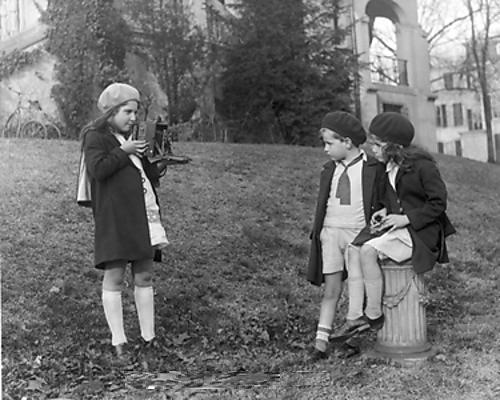
Berets: Country Trends--United States

Figure 1.--Berets were worn by both American boys and girls in the inter-War period, but there were substantial age differences. Girls of all ages wore them, but mostly younger pre-school boys. This family snapshot was probably taken around 1930. The children look to be about 5-10 years old. After World War II we rarely see boys wearing berets except for Scouts. A reader writes, "I suspect that the beret being associated with France had a upper class social status associated with it. I don't have a lot of direct evidence except for the photographic record."
|
|
Some American boys during the late 19th century wore "tams" withs dressy outfits. They were much larger than modern berets and normally worn with dressy outfits. The classic beret was worn by small boys in America during the 1920s-40s as part of a dressy outtfit. The chronology dsuggests that it was a style which developed as part of the connections with France after world War I. We are not sure about the social class connotations. Berets were never worn by American boys as casual clothing. Berets were occassionaly worn during the 1950s, but not commonly. Almost always American boys wore white or cream colored berets with dressy clothes. Slightly older boys might wear a paeked cap with dressy outfits. I am not sure why the light-colored berets were preferred in America. Notably French boys did not wear white berets. This convention in America was very common for boys who wore them. The beret was, however, generally considered in America as girls' headwear. As we have seen in many other instances, garments considered as girlish are usually rejected by boys. American girls wore berets in a wider range of colors. Girls wore them extensively in the 1920s-30s, calling them "tams". We suspect that this may have been a French influence, however, in France it was mostly boys who wore berets. We are not entirely sure about French girls. The beret was little seen in the United States after the 40s as boys' wears, until some Scout groups adopted red berets during the 1960s.
Some American boys during the late 19th century wore "tams" withs dressy outfits. They were much larger than modern berets and normally worn with dressy outfits. The classic beret was worn by small boys in America during the 1920s-40s as part of a dressy outtfit. The chronology dsuggests that it was a style which developed as part of the connections with France after world War I. Our information is limited at this time because we hsve so few examples in our photographic archive. We are not sure about the social class connotations. Berets were never worn by American boys as casual clothing. Berets were occassionaly worn during the 1950s, but not commonly. Almost always American boys wore white or cream colored berets with dressy clothes. Slightly older boys might wear a paeked cap with dressy outfits. I am not sure why the light-colored berets were preferred in America. Notably French boys did not wear white berets. This convention in America was very common for boys who wore them. The beret was little seen in the United States after the 40s as boys' wears, until some Scout groups adopted red berets during the 1960s.
The beret was, however, generally considered in America as girls' headwear. As we have seen in many other instances, garments considered as girlish are usually rejected by boys. American girls wore berets in a wider range of colors. Girls wore them extensively in the 1920s-30s, calling them "tams". We are not sure yet about the 1910s, but the think it was the inter-War era when they wre most popular. We believe the term tam was used much more extensively than beret, at least by the girls. They were worn of the most commonly worn types of headwear by girls. I'm not sure why they were so popular. Nor are we all together sure the girls saw beret/tams as a French garment. We suspect that this may have been a French influence, however, in France it was mostly boys who wore berets. We are not entirely sure about French girls. We mostly notice dark, solid colored beret. There were patterned berets, but I don't think thst they were very common.
HBC

Navigate the Boys' Historical Clothing Web Site:
[Return to the Main beret country page]
[Return to the Main hair style page]
[Introduction]
[Activities]
[Biographies]
[Chronology]
[Clothing styles]
[Countries]
[Topics]
[Bibliographies]
[Contributions]
[FAQs]
[Glossaries]
[Images]
[Links]
[Registration]
[Tools]
[Boys' Clothing Home]
Created: December 6, 2002
Last edited: 10:39 AM 2/24/2016



